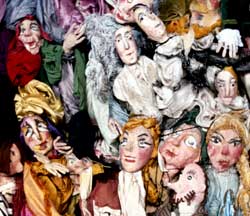
 Collezione
Maria Signorelli
Collezione
Maria Signorelli
Puppets of Maria Signorelli
The
Puppets of
Maria Signorelli
The fairy tales, nursery rhymes and films
Shows with classical and modern texts, films
The ballets of Maria Signorelli
19th-20th century Italian rod and glove puppets
19th-20th century Italian marionettes
20th century foreign rod and string puppets
Sicilian, Pugliese and Neapolitan puppets
Toy
rod, glove and string puppets
Paper and card theatres, sets and characters
Scripts
of puppet and marionette plays
Posters
of puppet theatre productions and festivals
Maria Signorelli’s puppets are of several hundred characters created from the 1940s to the 1990s for 159 different productions; for dance shows, for fairy tales, nursery rhymes and films for children, for plays with classical and modern texts, and film.
They are difficult to define as regards typology, because the artist constructed them according to their individual requirements, that is, the movement and function they had to have on stage.
Thus some dance puppets are rod puppets, because this left the legs free to execute ronds de jambe and other movements of classical dance.
Other characters, such as the princesses of fairy tales, or animals, are glove puppets, because the puppet of this type is capable of great expressivity: it can bow, embrace a friend, lie down and sleep - all actions required in certain stories.
In other characters the glove puppet structure is combined with that of rod puppet; for example, the Pianist in Allegro con brio can move the body freely (thanks to the rod) and move the fingers on the keys at the same time. A puppet like this is operated by five people, because the crescendo in the music is made visual by increasing the number of hands, finishing with eight.
Other puppets, used for what was called ‘black theatre’, are moved from behind with the aid of five rods fixed to the head and limbs, and are operated by three people, just like Bunraku theatre.
In ‘table theatre’ the characters are like ninepins, that the actor-puppeteer moves on the table, in a very simple way. Maria Signorelli invented inspired solutions to make visible, for example, the opening of the mouth of an opera singer: by sliding a cardboard tube (on which a very long throat is painted), inside another, the mouth can be closed and opened wide in a grotesque way.
To move the eyes, she often attached buttons or little coloured balls to pins, so that when the puppet moves they are made to sway expressively.
To make the hair, for example in Prokofiev’s Cinderella, she used gilt or silvered steel wool, that in her hands was transformed into towering curly wigs.
Signorelli’s puppets are based on inventive but simple construction techniques: rather than on mechanical contraptions, she relied on the specific magic of certain materials and rigorous study of visual perception, that then allowed her, thanks to materials of a certain type or arranged in a special way, to obtain effects for which other puppeteers would use internal structures, like rods, handles, strings or other devices. Hence she used materials that she herself could create or operate, such as papier mâché or cloth; she did not like polystyrene, foam rubber, wood paste or materials that offered greater resistance to her creativity.
Signorelli’s puppets ranged from a minimum of 50cm in height to one metre and even to 1.5m.
The spread of television led her in the final years to polish her
creations with regard to the early years, because close-ups diminished the expressivity based on deformities which had long
characterized her style.
